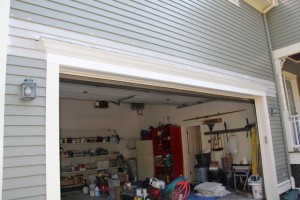

Do you have a garage door with flat trim casing on all three sides?
Crown molding applied to the top of a garage door can make a dramatic statement and increase the curb appeal of your garage entry. Curb appeal is the first impression the house makes to a visitor from the outside.
On a recent project we were asked to dress up a garage door with 4″ crown molding.
The customer wanted us to use something that would not rot, so we chose to use Azek PVC trim, and PVC crown molding.
This is a simple upgrade that can be accomplished in four to six hours. In order to apply crown molding to the top of the garage door you also need to apply a “roof” on top of it.
Here’s how we did it:
1. We removed the surrounding clapboards to expose the house wrap
2. We replaced the flat 1″x10″ trim with PVC trim. We ripped a 12 degree rip on top of this trim to accept the “roof” trim. Screws were placed high enough to be hidden by the crown molding.
3. We attached a 1″ x 4″ PVC “roof” trim on top of the garage trim. This board has a 12 degree rip against the house and is fastened to the 12 degree cut we put on the flat trim board. Screws are fine for this attachment, glue and screws is better.
4. The pitched “roof” board is slanted to shed water away from the house.
5. The garage was 24′ long so we had to install the crown molding in two pieces. We cut a 45 degree cut on the end of the crown molding and mated the two. Because we were using PVC we were able to use the PVC glue on everything.
6. Forty five degree return cuts on either end were made to return to the house.
7. Rubber flashing tape was installed under the crown molding and onto the clapboard below. The rubber tape under the crown returns will ensure that any water that gets into the clapboard seams makes it to the outside world.
8. Rubber flashing tap was installed on top of the slanted roof and up the side wall of the house. Care was taken to install the flashing tape under the existing Typar house wrap. the purpose of this overlap is to ensure that moisture running down a wall does not enter an upward facing seam. Overlapping seams ensures water drains down and hopefully out and away from the house.
We topped off the slanted roof trim with lead flashing that also runs up the house wall. Tyvek sealed off the seams of the lead and Typar.
9. Pre-primed cedar clapboards were reinstalled with stainless steel nails. We always take the time to prime the end grain and any fresh cuts we make. Any clapboard butt seams had t
10. The clapboards at the crown molding returns need to be scribed and cut with a jigsaw. All seams are then caulked.
